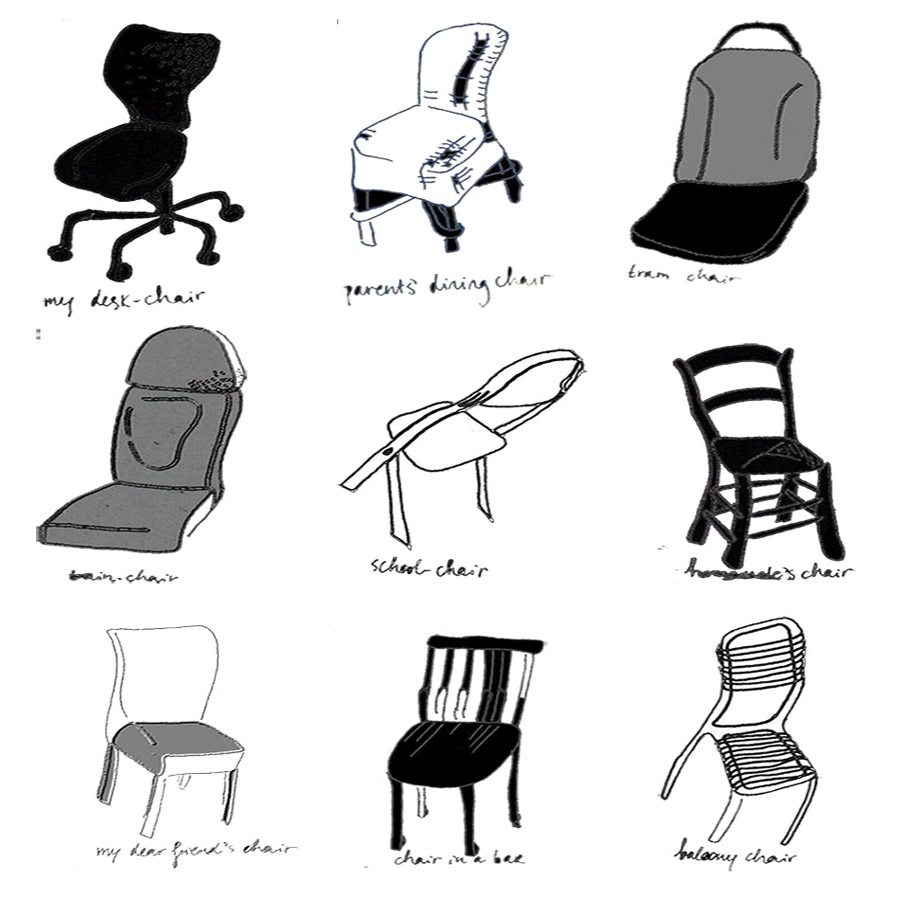This is how I remember my grandfather’s chair. I remember how I used to watch him sit on it. Or, sit in it. The chair was big and my grandfather had then already begun to become tiny. It was as though this chair, with its plumpness, its doubtful green color and its leather cushions pushing into skin, offered him an escape.
Since then I’ve never seen anyone sit and disappear like him.
Maybe people don’t have the time.
Maybe people don’t have the space.
Maybe people don’t have the guts.
_________________________________________________________________________
Human beings are standing beings; our muscles are constantly at work to keep us up, while gravity is constantly pulling us down. Keeping this in mind, sitting seems to be merely a way to discharge these muscles, to compensate for the unnatural posture that is ours as a result of evolution.
It is compensation that shows that even though we’re trying (as we are developing new techniques and exploring new ways of enhancement every day) we have not reached the state of super human yet. We are still in some state where we possess human intelligence, but are trapped in our animal bodies.
To sit is to accept this animal body.
– or is it?
It is easy to speak of only physical aspects in regard to sitting. However, as both the brain and the rest of our body are part of the same nervous system, there is of course a connection between our mind and body; these two influence each other every second of every day.
Having the object ‘chair’ as a framework, I’m interested in how this chair can, being a specific physical condition, extort or stimulate a specific mental condition. A desk-chair for instance has another mental state as a purpose than a dining chair; there is concentration on the one hand and relaxation on the other.
To explore this, I’ve been sketching chairs I come across lately. By doing so, I aimed to assemble a variety of chairs, carrying a variety of different appearances, to see what the similarities are.
As it turns out, the designs of these chairs share quite some similarities (even though the chairs don’t all share the same purpose). You can see that none of them have armrests, for instance. Partly due to this, none of them seem to be ‘heavy’. All of them are quite small and all fitted in the place where I encountered them.
__________________________________________________________________________
I feel like these daily chairs, that I will refer to as fast-chairs, trigger two reactions in us;
Firstly, awareness of one’s surroundings: these chairs are in a way elongations of what is already there, instead of autonomous objects. This stimulates a way of living in which one is always cautiously aware of what is happening around him, and therefore less aware of what is happening within himself. Society tends to distract us from ourselves. As we are being placed in groups everywhere and also forced to function within these groups, we are reminded that it is these surroundings that matter; it is the society around you that you should play your part in.
Secondly, these fast-chairs stimulate fast-thinking: the lack of armrests, the light feel; all of these elements make that these chairs are only shortly used. As we rush through the day, we accept the world we live in and try to give the right answers to it. Who still dares to propose deliberate questions, though? Who still dares to sit alone, and be consumed by existential thoughts? Who still dares to disappear, like my grandfather would?
Considering the second thought, it is interesting to refer to Daniel Kahneman, a psychologist whose book ‘Thinking, fast and slow’, was published in 2011.
In his book, Kahneman distinguishes two systems of thought: “System 1” is fast, instinctive, stereotypical and emotional; “System 2” is slower, more deliberative, more calculating and more logical. System 1 is much more frequently used than System 2, explains Kahneman in the following interview:
As Kahneman distinguishes these models of thinking, you could also distinguish two types of chairs. Type 1 is the fast-chair I mentioned earlier and Type 2 is the slow-chair ; the type of which there are less and less to be seen in our daily routine. This I consider as a scary thing, since the level of critical, individual thinking might follow the way down.
__________________________________________________________________________
It’s in my grandfather’s living room where you can find the slow-chair. Sitting in his chair caused for him the seemingly paradoxical situation where while surrendering his physical control, he gained mental control. Because of its physicallities (pointing towards the plumpness I talked about before), this chair was something autonomous:
It didn’t need my grandfather to sit in it to exist, my grandfather needed this chair to exist.

